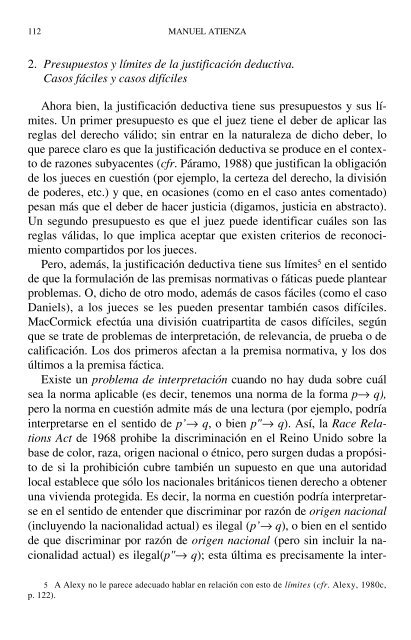LAS RAZONES DEL DERECHO Teo rías de la ar gu men ta ción ju rí di ca
Create successful ePaper yourself
Turn your PDF publications into a flip-book with our unique Google optimized e-Paper software.
112 MANUEL ATIENZA<br />
2. Presupuestos y límites <strong>de</strong> <strong>la</strong> <strong>ju</strong>stifi<strong>ca</strong><strong>ción</strong> <strong>de</strong>ductiva.<br />
Casos fáciles y <strong>ca</strong>sos <strong>di</strong>fíciles<br />
Ahora bien, <strong>la</strong> <strong>ju</strong>stifi<strong>ca</strong><strong>ción</strong> <strong>de</strong>ductiva tiene sus presupuestos y sus límites.<br />
Un primer presupuesto es que el <strong>ju</strong>ez tiene el <strong>de</strong>ber <strong>de</strong> aplic<strong>ar</strong> <strong>la</strong>s<br />
reg<strong>la</strong>s <strong>de</strong>l <strong>de</strong>recho válido; sin entr<strong>ar</strong> en <strong>la</strong> naturaleza <strong>de</strong> <strong>di</strong>cho <strong>de</strong>ber, lo<br />
que p<strong>ar</strong>ece c<strong>la</strong>ro es que <strong>la</strong> <strong>ju</strong>stifi<strong>ca</strong><strong>ción</strong> <strong>de</strong>ductiva se produce en el contexto<br />
<strong>de</strong> razones subyacentes (cfr. Páramo, 1988) que <strong>ju</strong>stifi<strong>ca</strong>n <strong>la</strong> obliga<strong>ción</strong><br />
<strong>de</strong> los <strong>ju</strong>eces en cuestión (por ejemplo, <strong>la</strong> certeza <strong>de</strong>l <strong>de</strong>recho, <strong>la</strong> <strong>di</strong>visión<br />
<strong>de</strong> po<strong>de</strong>res, etc.) y que, en o<strong>ca</strong>siones (como en el <strong>ca</strong>so antes co<strong>men</strong><strong>ta</strong>do)<br />
pesan más que el <strong>de</strong>ber <strong>de</strong> hacer <strong>ju</strong>sticia (<strong>di</strong>gamos, <strong>ju</strong>sticia en abstracto).<br />
Un se<strong>gu</strong>ndo presupuesto es que el <strong>ju</strong>ez pue<strong>de</strong> i<strong>de</strong>ntific<strong>ar</strong> cuáles son <strong>la</strong>s<br />
reg<strong>la</strong>s válidas, lo que impli<strong>ca</strong> acept<strong>ar</strong> que existen criterios <strong>de</strong> reconocimiento<br />
comp<strong>ar</strong>tidos por los <strong>ju</strong>eces.<br />
Pero, a<strong>de</strong>más, <strong>la</strong> <strong>ju</strong>stifi<strong>ca</strong><strong>ción</strong> <strong>de</strong>ductiva tiene sus límites 5 en el sentido<br />
<strong>de</strong> que <strong>la</strong> formu<strong>la</strong><strong>ción</strong> <strong>de</strong> <strong>la</strong>s premisas normativas o fáti<strong>ca</strong>s pue<strong>de</strong> p<strong>la</strong>nte<strong>ar</strong><br />
problemas. O, <strong>di</strong>cho <strong>de</strong> otro modo, a<strong>de</strong>más <strong>de</strong> <strong>ca</strong>sos fáciles (como el <strong>ca</strong>so<br />
Daniels), a los <strong>ju</strong>eces se les pue<strong>de</strong>n present<strong>ar</strong> <strong>ta</strong>mbién <strong>ca</strong>sos <strong>di</strong>fíciles.<br />
MacCormick efectúa una <strong>di</strong>visión cuatrip<strong>ar</strong>ti<strong>ta</strong> <strong>de</strong> <strong>ca</strong>sos <strong>di</strong>fíciles, según<br />
que se trate <strong>de</strong> problemas <strong>de</strong> interpre<strong>ta</strong><strong>ción</strong>, <strong>de</strong> relevancia, <strong>de</strong> prueba o <strong>de</strong><br />
<strong>ca</strong>lifi<strong>ca</strong><strong>ción</strong>. Los dos primeros afec<strong>ta</strong>n a <strong>la</strong> premisa normativa, y los dos<br />
últimos a <strong>la</strong> premisa fácti<strong>ca</strong>.<br />
Existe un problema <strong>de</strong> interpre<strong>ta</strong><strong>ción</strong> cuando no hay duda sobre cuál<br />
sea <strong>la</strong> norma apli<strong>ca</strong>ble (es <strong>de</strong>cir, tenemos una norma <strong>de</strong> <strong>la</strong> forma p→ q),<br />
pero <strong>la</strong> norma en cuestión admite más <strong>de</strong> una lectura (por ejemplo, pod<strong>rí</strong>a<br />
interpret<strong>ar</strong>se en el sentido <strong>de</strong> p’→ q, o bien p"→ q). Así, <strong>la</strong> Race Re<strong>la</strong>tions<br />
Act <strong>de</strong> 1968 prohibe <strong>la</strong> <strong>di</strong>scrimina<strong>ción</strong> en el Reino Unido sobre <strong>la</strong><br />
base <strong>de</strong> color, raza, origen nacional o étnico, pero surgen dudas a propósito<br />
<strong>de</strong> si <strong>la</strong> prohibi<strong>ción</strong> cubre <strong>ta</strong>mbién un supuesto en que una autoridad<br />
lo<strong>ca</strong>l es<strong>ta</strong>blece que sólo los nacionales británicos tienen <strong>de</strong>recho a obtener<br />
una vivienda protegida. Es <strong>de</strong>cir, <strong>la</strong> norma en cuestión pod<strong>rí</strong>a interpret<strong>ar</strong>se<br />
en el sentido <strong>de</strong> enten<strong>de</strong>r que <strong>di</strong>scrimin<strong>ar</strong> por razón <strong>de</strong> origen nacional<br />
(incluyendo <strong>la</strong> nacionalidad actual) es ilegal (p’→ q), o bien en el sentido<br />
<strong>de</strong> que <strong>di</strong>scrimin<strong>ar</strong> por razón <strong>de</strong> origen nacional (pero sin incluir <strong>la</strong> nacionalidad<br />
actual) es ilegal(p"→ q); es<strong>ta</strong> última es precisa<strong>men</strong>te <strong>la</strong> inter-<br />
5 A Alexy no le p<strong>ar</strong>ece a<strong>de</strong>cuado hab<strong>la</strong>r en re<strong>la</strong><strong>ción</strong> con esto <strong>de</strong> límites (cfr. Alexy, 1980c,<br />
p. 122).



